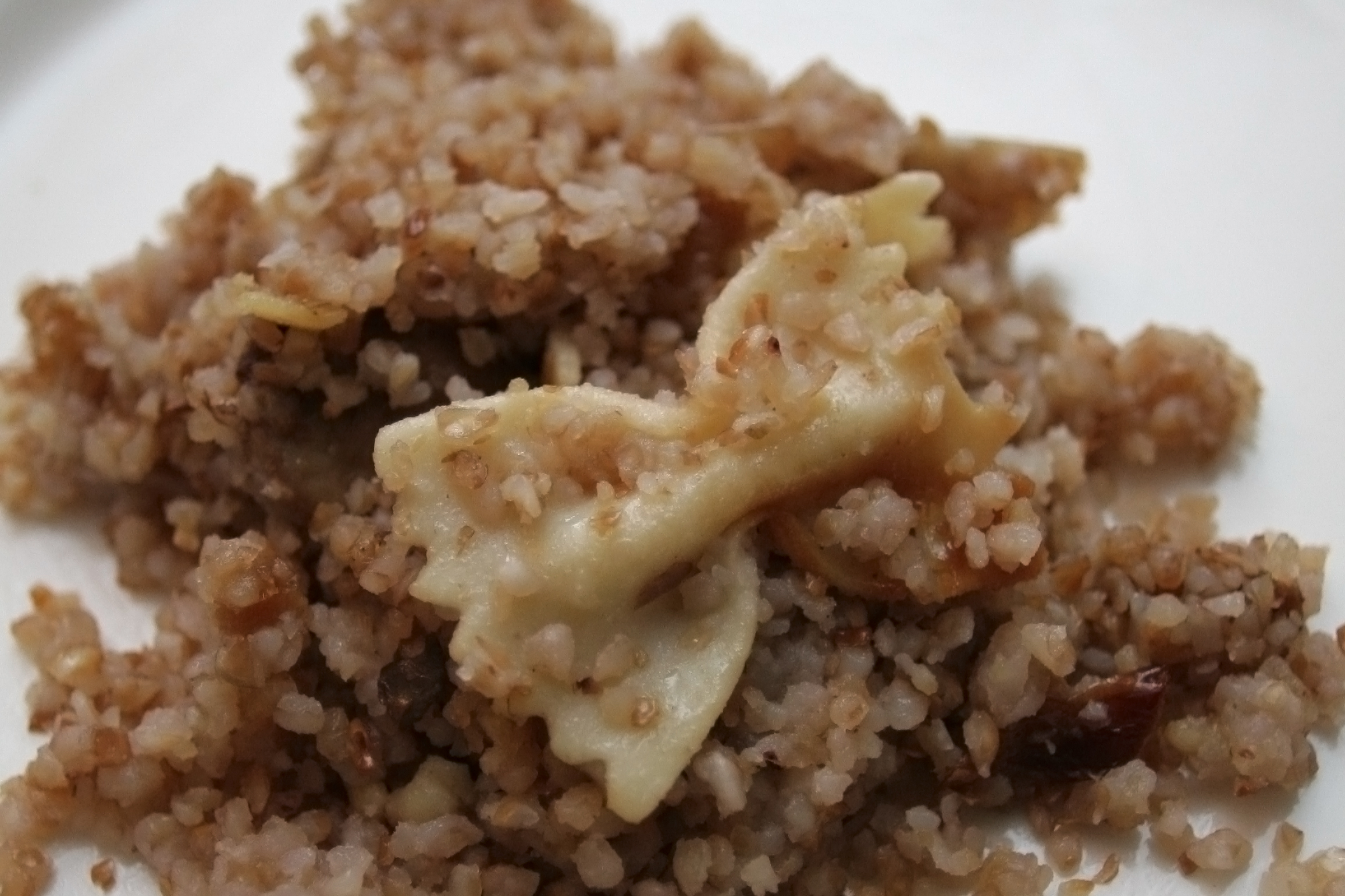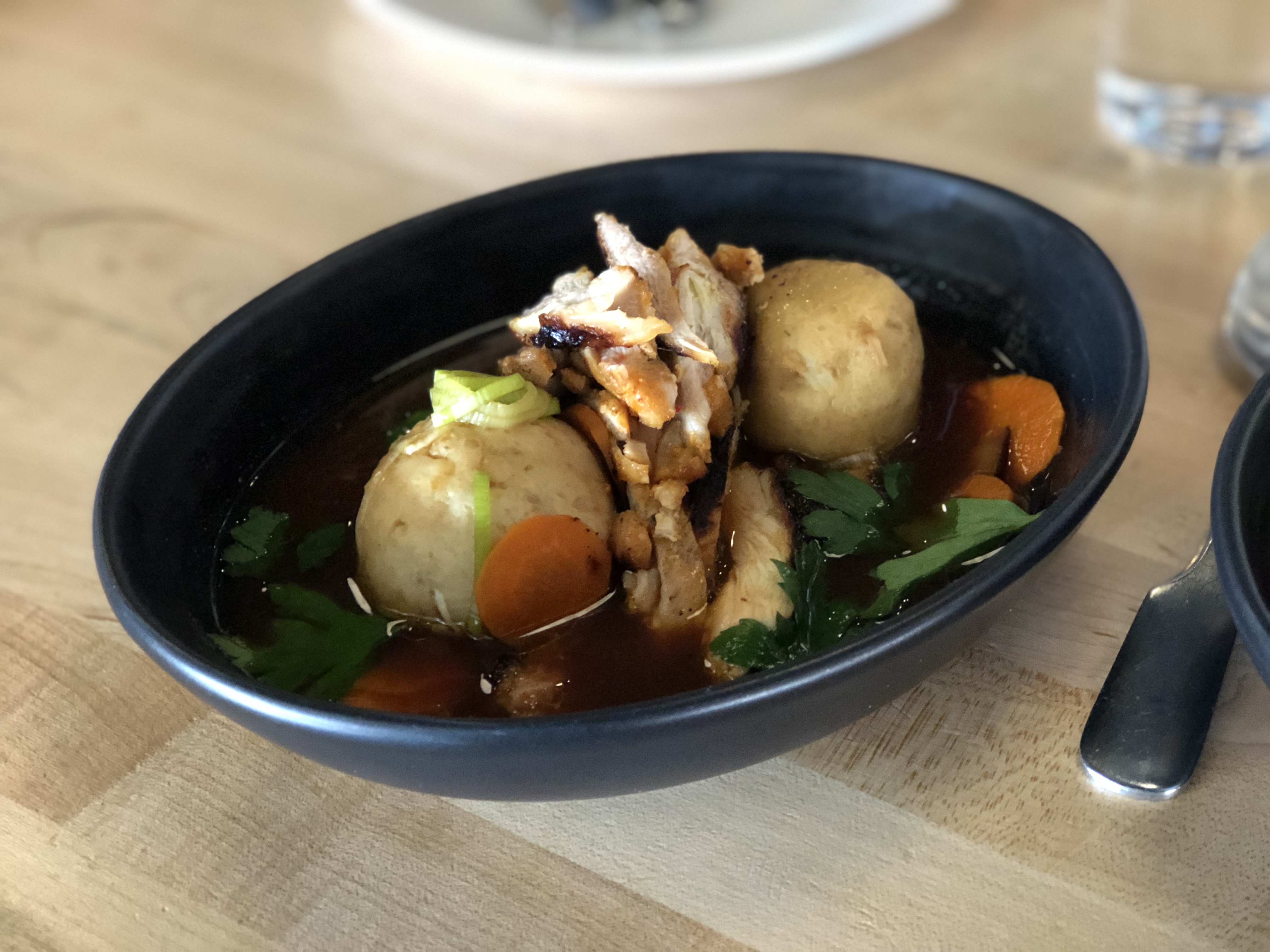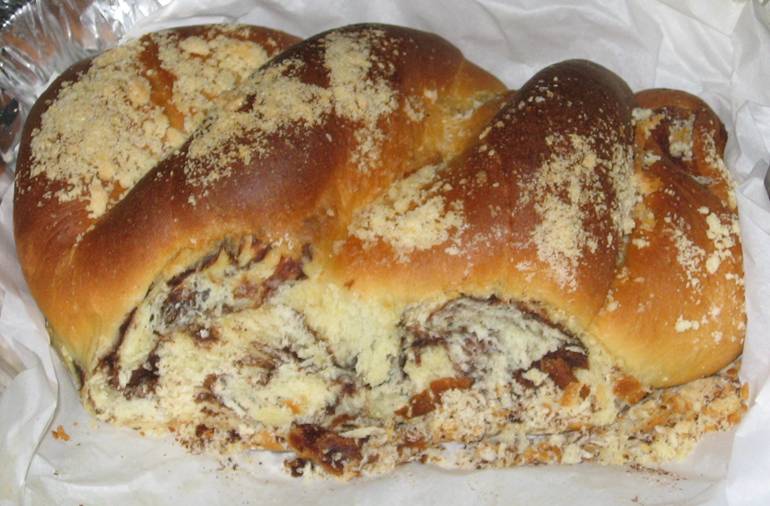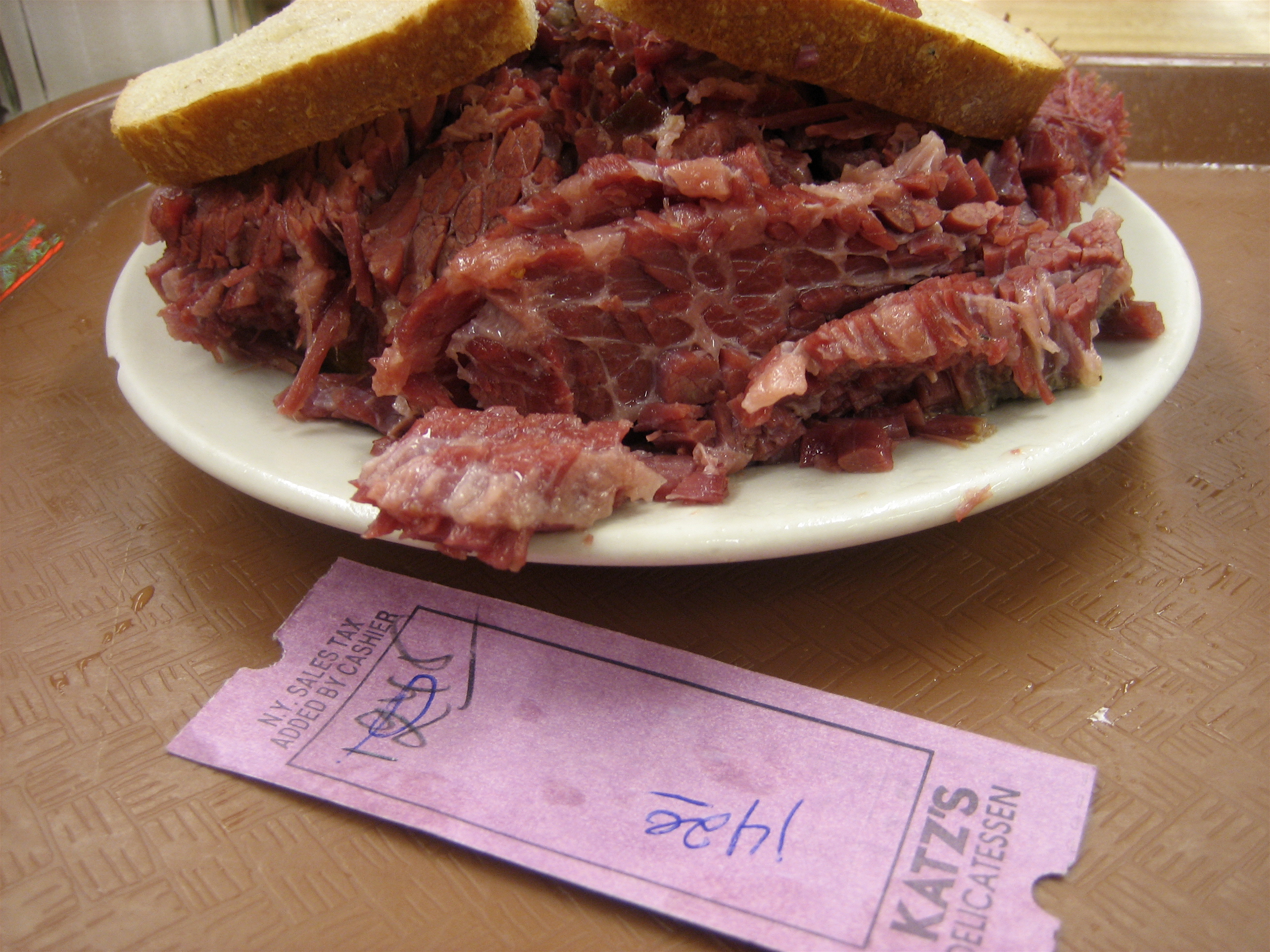|
Kasha Varnishkes
Kashe varnishkes (sometimes Americanized as kasha varnishkas) is a traditional dish of the American-Jewish Ashkenazi community. It combines ''kasha'' (buckwheat groats) with noodles, typically bow-tie shape lokshen egg noodles. Buckwheat groats (''gretshkes/greytshkelach'' or ''retshkes/reytshkelach'' in Yiddish) are prepared separately from, and then fried together with, '' lokshen'' and ''tsvibelach'' (onions) in ''schmaltz'' (poultry fat). Sometimes ''briye'' (chicken or beef stock) is used in the preparation. Origins Kasha varnishkes are part of Ashkenazi Jewish cuisine. The Ashkenazi Jewish communities of Eastern Europe fled Europe due to rising antisemitism and pogroms and sought refuge in the United States and other countries, and brought with them food of their tradition including kasha varnishkes to America and it is widely popular in the American Jewish cuisine and community. The name and the dish ''varnishkes'' as a whole seems to be a Yiddish adaptation of the Ukra ... [...More Info...] [...Related Items...] OR: [Wikipedia] [Google] [Baidu] |
Pogroms
A pogrom () is a violent riot incited with the aim of massacring or expelling an ethnic or religious group, particularly Jews. The term entered the English language from Russian to describe 19th- and 20th-century attacks on Jews in the Russian Empire (mostly within the Pale of Settlement). Similar attacks against Jews which also occurred at other times and places retrospectively became known as pogroms. Sometimes the word is used to describe publicly sanctioned purgative attacks against non-Jewish groups. The characteristics of a pogrom vary widely, depending on the specific incident, at times leading to, or culminating in, massacres. Significant pogroms in the Russian Empire included the Odessa pogroms, Warsaw pogrom (1881), Kishinev pogrom (1903), Kiev pogrom (1905), and Białystok pogrom (1906). After the collapse of the Russian Empire in 1917, several pogroms occurred amidst the power struggles in Eastern Europe, including the Lwów pogrom (1918) and Kiev Pogroms (191 ... [...More Info...] [...Related Items...] OR: [Wikipedia] [Google] [Baidu] |
Ashkenazi Jewish Cuisine
Ashkenazi Jewish cuisine is an assortment of cooking traditions that was developed by the Ashkenazi Jews of Eastern, Central, Western, Northern, and Southern Europe, and their descendants, particularly in the United States and other Western countries. Ashkenazi Jewish foods have frequently been unique to Ashkenazi Jewish communities, and they frequently consist of local ingredients (such as beets, cabbage, and potato), all of which are generally prepared in accordance with the laws of ''kashrut''. Some of these ingredients have not been popular in local or neighbouring non-Jewish communities due to a history of limited interaction between Ashkenazi Jews and non-Jews. The cuisine is largely based on ingredients that were affordable to the historically poor Ashkenazi Jewish community of Europe, and it is frequently composed of ingredients that were readily available and affordable in the regions and communities of Europe in which Ashkenazi Jews lived. Some ingredients were consi ... [...More Info...] [...Related Items...] OR: [Wikipedia] [Google] [Baidu] |
List Of Jewish Cuisine Dishes
Below is a list of dishes found in Jewish cuisine. Traditional Ashkenazi dishes Ashkenazi Jews are the Jews descended from the medieval Jewish communities of the Rhineland in the west of Germany. Ashkenazim or Ashkenazi Jews are literally referring to "German Jews." Many Ashkenazi Jews later migrated, largely eastward, forming communities in non German-speaking areas, including Bohemia (Czech Republic), Hungary, Poland, Lithuania, Latvia, Russia, Ukraine, Romania, Belarus, and elsewhere between the 10th and 19th centuries. As many of these countries share similar dishes, and were occupied by the Russian and Austro-Hungarian Empires until the end of World War I, the place where the dish originated is uncertain. Sephardi and Mizrahi dishes This section makes reference to the cuisine of the Jews from the Mediterranean and the Middle East. Sephardim are a subgroup of Jews originating in the Iberian Peninsula (modern Spain and Portugal). After being expelled from Spain and Portugal ... [...More Info...] [...Related Items...] OR: [Wikipedia] [Google] [Baidu] |
List Of Buckwheat Dishes
This is a list of buckwheat dishes, consisting of dishes that use buckwheat as a main ingredient. Buckwheat is a plant cultivated for its grain-like seeds and as a cover crop. A related and more bitter species, ''Fagopyrum tataricum'', a domesticated food plant common in Asia, but not as common in Europe or North America, is also referred to as buckwheat. Buckwheat dishes * Ajdovi žganci – translates to English as "buckwheat spoonbread". It is a national Slovene dish. * ''Broeder'' – a traditional Dutch dish: a batter with buckwheat flour, yeast, and other ingredients is boiled in a cotton bag. * Buckwheat pancake :* '' Blini'' – an Eastern European pancake made with buckwheat flour :* '' Kaletez'' – a Breton pancake made with buckwheat flour :* '' Memil-buchimgae'' – a Korean pancake made with buckwheat flour :* '' Ploye'' – a pancake made of buckwheat flour, wheat flour, baking powder and water popular in Northeastern Canada and the United States * Crêpe br ... [...More Info...] [...Related Items...] OR: [Wikipedia] [Google] [Baidu] |
Gil Marks
Gilbert Stanley Marks (May 30, 1952 – December 5, 2014) was an American food writer and historian noted for his reference and cookbooks on the subject of Jewish food. He was the founding editor of ''Kosher Gourmet'' magazine. He moved to Israel and became a citizen in 2012 and died of lung cancer on December 5, 2014, at the hospice at Hadassah Hospital in Jerusalem. Education Marks was born in 1952 in Charleston, West Virginia. After graduating from high school at Talmudical Academy of Baltimore, Marks studied at Yeshiva University, and graduated with an M.A. in Jewish history, M.S.W. in social work and rabbinical ordination from Rabbi Isaac Elchanan Theological Seminary, a Yeshiva University affiliate. Published works Marks was the founding editor of ''Kosher Gourmet'' magazine, in 1986, which ran for about six years before closing in the early 1990s. The following books written by Marks have been published: * ''The World of Jewish Cooking: More Than 500 Traditional Recipes ... [...More Info...] [...Related Items...] OR: [Wikipedia] [Google] [Baidu] |
Abraham Goldfaden
Abraham Goldfaden (Yiddish: אַבֿרהם גאָלדפֿאַדען; born Avrum Goldnfoden; 24 July 1840 – 9 January 1908), also known as Avram Goldfaden, was a Russian-born Jewish poet, playwright, stage director and actor in the languages Yiddish and Hebrew, author of some 40 plays. Goldfaden is considered the father of modern Jewish theatre. In 1876 he founded in Romania what is generally credited as the world's first professional Yiddish-language theater troupe. He was also responsible for the first Hebrew-language play performed in the United States. The Avram Goldfaden Festival of Iaşi, Romania, is named and held in his honour. Jacob Sternberg called him "the Prince Charming who woke up the lethargic Romanian Jewish culture." Israil Bercovici wrote of his works: "we find points in common with what we now call 'total theater'. In many of his plays he alternates prose and verse, pantomime and dance, moments of acrobatics and some of ''jonglerie'', and even of spiritu ... [...More Info...] [...Related Items...] OR: [Wikipedia] [Google] [Baidu] |
Ukrainian Jews
The history of the Jews in Ukraine dates back over a thousand years; Jewish communities have existed in the territory of Ukraine from the time of the Kievan Rus' (late 9th to mid-13th century). Some of the most important Jewish religious and cultural movements, from Hasidism to Zionism, rose either fully or to an extensive degree in the territory of modern Ukraine. According to the World Jewish Congress, the Jewish community in Ukraine constitutes the third-largest in Europe and the fifth-largest in the world. The actions of the Soviet government by 1927 led to a growing antisemitism in the area.Сергійчук, В. Український Крим К. 2001, p.156 Total civilian losses during World War II and the Reichskommissariat Ukraine, German occupation of Ukraine are estimated at seven million. More than one million Soviet Jews, of them around 225,000 in Belarus, were shot and killed by the Einsatzgruppen and by their many local Ukrainian supporters. Most of them wer ... [...More Info...] [...Related Items...] OR: [Wikipedia] [Google] [Baidu] |
Varenyky
Pierogi are filled dumplings made by wrapping unleavened dough around a savory or sweet filling and cooking in boiling water. They are often pan-fried before serving. Pierogi or their varieties are associated with the cuisines of Central, Eastern and Southeastern Europe. Dumplings most likely originated in Asia and came to Europe via trade in the Middle Ages. The widely-used English name pierogi was derived from Polish. In some parts of Eastern Europe they are known as varenyky''.'' Pierogi are also popular in modern-day American and Canadian cuisine, where they are sometimes known under different local names. Typical fillings include potato, cheese, quark, sauerkraut, ground meat, edible mushrooms, and/or fruits. Savory pierogi are often served with a topping of sour cream, fried onions, or both. Terminology The English word "pierogi" comes from Polish ' , which is the plural form of ' , a generic term for filled dumplings. It derives from Old East Slavic (') and furt ... [...More Info...] [...Related Items...] OR: [Wikipedia] [Google] [Baidu] |
American Jewish Cuisine
American Jewish cuisine comprises the food, cooking, and dining customs associated with American Jews. It was heavily influenced by the cuisine of Jewish immigrants who came to the United States from Eastern Europe around the turn of the 20th century. It was further developed in unique ways by the immigrants and their descendants, especially in New York City and other large metropolitan areas of the northeastern U.S. History Between 1881 and 1921, around 2.5 million Jews immigrated to the United States from Eastern Europe. Most of them settled in large cities in the northeastern part of the country, especially New York, Philadelphia, Boston, Cleveland, Chicago, and Baltimore. These immigrants brought with them a well-developed culinary heritage. The cuisine continued to evolve in America, in the homes of the immigrants and their descendants, and in delicatessens and appetizing stores in New York City and elsewhere. Delicatessens were quite popular among second-generation Ameri ... [...More Info...] [...Related Items...] OR: [Wikipedia] [Google] [Baidu] |
Ashkenazi Jewish
Ashkenazi Jews ( ; he, יְהוּדֵי אַשְׁכְּנַז, translit=Yehudei Ashkenaz, ; yi, אַשכּנזישע ייִדן, Ashkenazishe Yidn), also known as Ashkenazic Jews or ''Ashkenazim'',, Ashkenazi Hebrew pronunciation: , singular: , Modern Hebrew: are a Jewish diaspora population who coalesced in the Holy Roman Empire around the end of the first millennium CE. Their traditional diaspora language is Yiddish (a West Germanic language with Jewish linguistic elements, including the Hebrew alphabet), which developed during the Middle Ages after they had moved from Germany and France into Northern Europe and Eastern Europe. For centuries, Ashkenazim in Europe used Hebrew only as a sacred language until the revival of Hebrew as a common language in 20th-century Israel. Throughout their numerous centuries living in Europe, Ashkenazim have made many important contributions to its philosophy, scholarship, literature, art, music, and science. The rabbinical term ... [...More Info...] [...Related Items...] OR: [Wikipedia] [Google] [Baidu] |
Kasha
In English, kasha usually refers to pseudocereal buckwheat or its culinary preparations. In various East-Central and Eastern European countries, ''kasha'' can apply to any kind of cooked grain. It can be baked but most often is boiled, either in water or milk, and therefore the term coincides with the English definition of ' porridge', but the word can also refer to the grain before preparation, which corresponds to the definition of ' groats'. This understanding of kasha concerns mainly Belarus (), the Czech Republic (), Lithuania (), Poland (), Romania and the Republic of Moldova (), Russia (), Slovakia (), Kazakhstan, and Ukraine (), where the term, besides buckwheat, can apply to wheat, barley, oats, millet and rye. Kashas have been an important element of Slavic diet for at least 1,000 years. This English-language usage probably originated with Jewish immigrants, as did the form ''kashi'' (literally translated as "porridges"). File:Kashagrains.png, Buckwheat ... [...More Info...] [...Related Items...] OR: [Wikipedia] [Google] [Baidu] |








